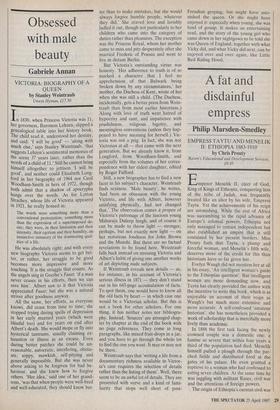Obsessed with male beauty
Gabriele Annan
VICTORIA: BIOGRAPHY OF A QUEEN by Stanley Weintraub
Unwin Hyman, £17.50
In 1830, when Princess Victoria was 11, her governess, Baroness Lehzen, slipped a genealogical table into her history book. The child read it, understood her destiny, and said: 'I will be good' — 'along with much else,' says Stanley Weintraub, 'that suggests Lehzen's sentimental memories of the scene 37 years later, rather than the words of a child of 11.' Still he cannot bring himself altogether to jettison 'I will be good', and neither could Elizabeth Long- ford in her biography of 1964 nor Cecil Woodham-Smith in hers of 1972, though both admit that a shadow of apocrypha hangs over the words. • As for Lytton Strachey, whose life of Victoria appeared in 1921, he really homed in:
The words were something more than a conventional protestation, something more than the expression of a superimposed de- sire; they were, in their limitation and their intensity, their egotism and their humility, an instinctive summary of the dominating qual- ities of a life.
He was absolutely right; and with every new biography Victoria seems to get bet- ter, or rather, her struggle to be good becomes more impressive and more touching. It is the struggle that counts. As the angels sing in Goethe's Faust: 'if a man never ceases in his efforts, then we can save him'. Albert saw to it that Victoria appreciated Faust; but she was a natural striver after goodness anyway. All the same, her efforts, as everyone knows, did cease from time to time; she stopped trying during spells of depression in her early married years (which were blissful too) and for years on end after Albert's death. She would mope or fly into hysterical tantrums, usually claiming ex- haustion or illness as an excuse. Even during better patches she could be un- reasonable, autocratic, interfering, obstin- ate, soppy, mawkish, self-pitying and generally impossible. But she was never above asking to be forgiven for bad be- haviour, and she knew how to forgive others. 'Her idea,' said one of her grand- sons, 'was that when people were well-bred and well-educated, they should know bet- ter than to make mistakes, but she would always forgive humble people, whatever they did.' She craved love and lavishly ladled it out, though not particularly to her children who came into the category of duties rather than pleasures. The exception was the Princess Royal, whom her mother came to miss and pity desperately after she married Frederic of Prussia and went to live in distant Berlin.
But Victoria's outstanding virtue was honesty. 'Her adherence to truth is of so marked a character that I feel no apprehension of that Bulwark being broken down by any circumstances,' her mother, the Duchess of Kent, wrote of her when she was still a child. (The Duchess, incidentally, gets a better press from Wein- traub than from most earlier historians.) Along with love of truth went hatred of hypocrisy and cant, and impatience with prudishness, religious bigotry, and meaningless conventions (unless they hap- pened to have meaning for herself.) Vic- toria was not a prig. In fact, she was not Victorian at all — that came with the next generation. But we already know it, from Longford, from Woodham-Smith, and especially from the volumes of her corres- pondence with her eldest daughter, edited by Roger Fulford.
Still, a new biographer has to find a new facet in his subject's character. Weintraub finds sexiness. 'Male beauty', he writes, tad been an obsession with the young Victoria, and life with Albert, however satisfying physically, had not changed that.' The observation comes a propos of Victoria's patronage of the luscious young Maharaja Duleep Singh; and of course it can be made to throw light — stronger, perhaps, but not exactly new light — on her notorious fondness for John Brown and the Munshi. But there are no factual revelations to be found here. Weintraub falls back instead on stressing Victoria and Albert's habit of giving one another works of art depicting nude subjects.
If Weintraub reveals new details — as, for instance, in his account of Victoria's serious illness in 1871 — they don't stand out in his 643-page accumulation of facts. To spot them, one would have to know all the old facts by heart — in which case one would be a Victorian scholar. But this is not a book for other scholars. For one thing, it has neither notes nor bibliogra- phy. Instead, 'Sources' are arranged chap- ter by chapter at the end of the book with no page references. They come in long paragraphs, like mixed fruit-drops in a jar, and you have to go through the whole lot to find the one you want. It may or may not be there.
Weintraub says that 'writing a life from a documentary richness available in Victor- ia's case requires the selection of details rather than the listing of them'. Well, there seem to be an awful lot of details. They are presented with verve and a kind of fami- liarity that stops well short of post- Freudian groping, but might have asto- nished the queen. Or she might have enjoyed it: especially when young, she was fond of gossip. It makes an entertaining read, and the story of the young girl who came down in her nightgown to be told she was Queen of England, together with what Vicky did, and what Vicky did next, can be enjoyed over and over again, like Little Red Riding Hood.


































































 Previous page
Previous page